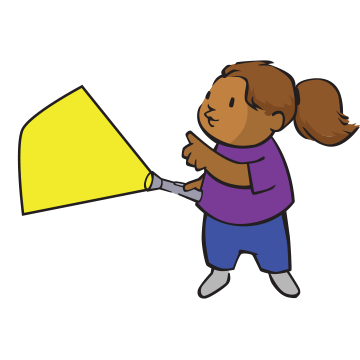Boston Children's Museum
308 Congress Street, Boston, MA 02210
617-426-6500
© Boston Children’s Museum 2025
Website Design by JackrabbitThis activity is a great introduction to both the behaviors of light and the properties of materials, and as a result works particularly well with your youngest children. Building a foundational understanding of how light behaves is central to astronomy and other sciences, and this foundation is best built through direct experiences like these.
This activity works best in a dark space. If it is difficult to get your room dark enough, you can drape a dark cloth over a table to create a cozy space to experiment.
This activity is primarily for younger children (under 6 or 7); though older children will likely still have fun.
Don’t hand out flashlights until after the Maker it Matter opening discussion – once they have flashlights in their hands, it will be difficult for your students to focus on anything else!

Ask your students if they have ever played with flashlights before. What do we use flashlights for? Have a flashlight in your hand, turn out the lights in the room if you can and ask your children what they can see in the dark. Turn on the flashlight, point it at something and ask your children what they can see now. Tell them they are going to play with flashlights and different materials to try to learn more about light.
Play with these materials and see what you can do with light!
After 10-15 minutes of experimenting, bring the group together (you will probably have to temporarily collect the flashlights – it will be difficult for children to concentrate on a conversation with flashlights in their hands). What kinds of things did they notice? What did they try to do with the light? Can they begin to list some rules about light? Start a list on chart paper (some rules that may come up include, “Light travels in a straight line.”, “Light can go through some things and not others.”, “The spot of light gets bigger the farther away it is from the floor.”, etc.). Some of these rules will be accurate and some may not be. Encourage more testing to validate or challenge some of these rules. You can do this just in this session, or over time, adding to and changing the list of rules as you keep testing.
If appropriate, you can also talk to your students about why studying light is important to scientists. When astronomers examine the light from stars, they can figure out a lot of information – not just that the star exists, or how bright it is; but also what it is made of, what temperature it is, its density, how fast it is moving, how strong its magnetic field is, and even how old it is. All by examining the light that shines from it! And every exoplanet and new solar system that was ever discovered was done so by examining the faint light from the distant stars that those planets orbit around.
Send children or teams back to experiment some more. If you have some of the additional materials (CDs, aluminum foil, kaleidoscopes, prisms, jars, etc.), hand them out to the teams and have them develop new experiments and observations. What happens if teams combine materials (ex. shining the light through tissue paper, pointed at a mirror? What if teams worked together and used multiple mirrors?). As a follow up, try the Bouncing Light activity from this curriculum.
Astronomers use a technique called spectroscopy – the study of light broken into its component colors, and the investigation and measurement of spectra produced when matter interacts with or emits electromagnetic radiation – to learn about distant objects. Studying light can tell us a lot – not just that an object (such as a star) exists, or how bright it is; but also what it is made of, what temperature it is, its density, how fast it is moving, how strong its magnetic field is, and even how old it is. All by examining the light it emits! Every exoplanet and new solar system ever discovered was done so by examining the faint light from distant stars.
Earth and Space science activities were developed with the support of NASA. This material is based upon work supported by NASA under grant award number NNX14AQ83G. Any opinions, findings, and conclusions or recommendations expressed in this material are those of the author(s) and do not necessarily reflect the views of the National Aeronautics and Space Administration (NASA).